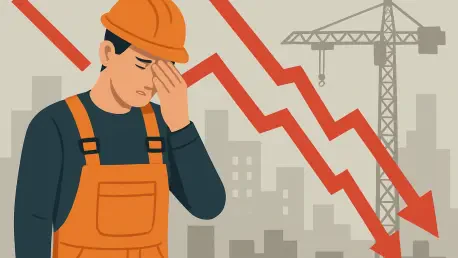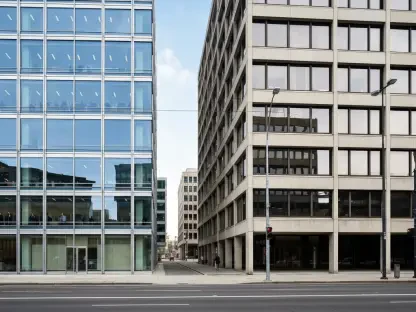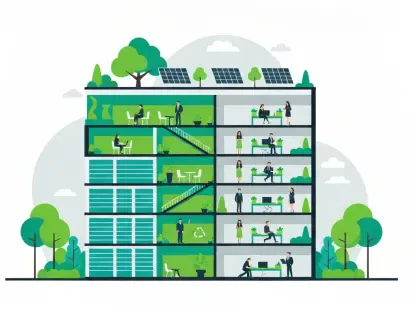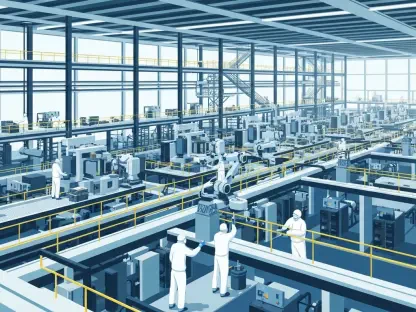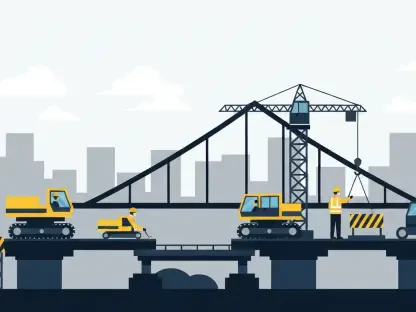The construction industry, often seen as a backbone of economic vitality, is facing an unexpected downturn this August, with a reported loss of 7,000 jobs compared to the previous month, signaling a troubling trend for the sector. This marks the third consecutive monthly decline, bringing total employment to 8,295,000, with only a negligible increase of 6,000 jobs since December of last year. Such stagnation raises pressing questions about the health of an industry critical to infrastructure, housing, and manufacturing. Beyond the raw numbers, deeper issues like policy uncertainties, labor shortages, and external disruptions are casting long shadows over both residential and nonresidential projects. This troubling scenario demands a closer look at the factors stifling growth and the broader implications for economic stability, as industry leaders call for urgent action to reverse the decline.
Unpacking the Employment Slowdown
Sector-Specific Job Losses
A detailed examination of the construction sector reveals uneven impacts across its various segments, with residential construction bearing the brunt of the decline at a loss of 6,100 jobs in August. This downturn has hit homebuilders and specialty contractors particularly hard, reflecting a broader hesitation in housing projects amid economic uncertainties. Nonresidential construction, while slightly less affected, still recorded a net loss of 1,200 jobs, with building construction and specialty trade contractors seeing reductions. However, a small bright spot exists in heavy and civil engineering firms, which gained 2,300 workers. These contrasting trends suggest that while certain infrastructure projects may be moving forward, the overall momentum in construction is faltering. The disparity between subsectors highlights the complexity of the challenges, as different areas grapple with unique pressures ranging from funding delays to shifting market demands.
Record-Low Unemployment Paradox
Despite the decline in jobs, the unemployment rate for construction workers reached a historic low of 3.2% in August, presenting a paradox that puzzles industry analysts. This figure, while seemingly positive, may not reflect a thriving job market but rather a shrinking workforce, as some workers appear to be exiting the industry altogether. Fears surrounding immigration enforcement actions are believed to play a significant role, potentially driving skilled laborers away from construction roles. According to expert analysis, this low unemployment rate masks deeper issues of retention and recruitment, as firms struggle to maintain a stable workforce. The implications are far-reaching, with critical projects facing delays due to insufficient labor. This situation underscores the need for targeted interventions to address not just job creation but also the underlying causes pushing workers out of the sector.
External Pressures Stifling Growth
Policy Uncertainties and Tariffs
The construction industry is increasingly caught in a web of policy uncertainties and trade disruptions, with tariffs emerging as a significant barrier to progress, as 16% of firms report project cancellations or delays due to these economic measures. Fluctuating federal policies on funding, taxes, and regulations have further compounded the issue, with 26% of companies citing setbacks linked to such changes. These external forces disrupt the demand for construction services, stalling projects that are essential for economic growth. Industry leaders argue that the constant shifts in trade policies create an unpredictable environment, making it difficult for firms to plan and invest with confidence. The ripple effects are felt across supply chains, as costs rise and timelines extend, ultimately hindering the sector’s ability to contribute to national development goals. Stabilizing these policies could be a critical step toward restoring momentum.
Impact of Immigration Enforcement
Another pressing challenge facing the construction sector is the impact of immigration enforcement actions, with 28% of firms noting disruptions to their projects over the past six months due to these measures. Such enforcement has intensified labor shortages, as many workers, fearing legal repercussions, opt to leave the industry or avoid certain job sites. This exodus exacerbates an already tight labor market, leaving companies struggling to meet project deadlines and maintain quality. The broader economic consequences are significant, as delays in infrastructure and housing projects hinder growth in related sectors. Industry advocates emphasize that misdirected enforcement efforts are not only stalling construction progress but also undermining the workforce diversity that has long been a strength of the field. Addressing these disruptions through refined policies could help mitigate the loss of talent and stabilize employment numbers.
Charting a Path Forward
Addressing Systemic Disruptions
Looking back, the construction industry faced a challenging August, marked by a decline of 7,000 jobs and persistent stagnation that hindered critical projects. The combined weight of policy uncertainties, tariffs, and immigration enforcement actions created a complex web of obstacles that firms struggled to navigate. Both residential and nonresidential segments felt the strain, with labor shortages and project delays becoming all too common. Industry leaders repeatedly highlighted the need for stability in trade and regulatory frameworks to prevent further erosion of employment figures. Reflecting on these events, it became clear that without targeted interventions, the sector risked deeper setbacks that could ripple through the broader economy.
Building a Resilient Future
Moving forward from the difficulties of August, actionable steps must prioritize stabilizing the policy environment to rebuild confidence within the construction sector. Policymakers should focus on consistent trade agreements and refined immigration enforcement strategies that support rather than disrupt the workforce. Additionally, investing in training programs to attract and retain skilled workers could address long-term labor shortages. Collaboration between industry stakeholders and government bodies will be essential to ensure that infrastructure and housing projects regain momentum. By tackling these systemic issues head-on, there is an opportunity to not only reverse the recent employment decline but also strengthen the foundation for sustainable growth in the years ahead.
